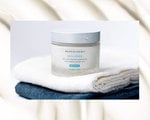How Do You Get an Even Skin Tone?
July 09, 2024
While sunscreen may not directly even skin pigmentation, it can help prevent existing discoloration from worsening: As mentioned, exposure to UV rays can cause (and exacerbate) an uneven skin tone. To shield your skin from those damaging rays, Dr. Kwan recommends avoiding excessive sun exposure and keeping your skin guarded with broad-spectrum sunscreen daily (yes, even on cold or cloudy days). In addition to sunscreen, be sure to wear protective clothing and seek shade when possible.
The best sunscreen is the one you’ll actually wear, so choose a formula that’s non-greasy and feels comfortable on the skin. There are plenty of great options on the market, but if you’re looking for something that feels super light, we suggest the Kiehl’s Better Screen UV Serum. The broad-spectrum formula has a serum-like texture, blends seamlessly across multiple skin tones, and layers beautifully under makeup. Plus, it helps brighten skin and correct the visible signs of aging—such as uneven skin tone and texture—with consistent use.

6. Keep your skin hydrated
The skin barrier is the outermost layer of your skin, and it helps protect your skin from stressors (like sun exposure and air pollution) that can contribute to an uneven skin tone. In order to keep this barrier in great shape, moisturizing is a must. “Skin moisture is composed of those lipids and water,” explains board-certified dermatologist Dr. Karan Lal. “We lose moisture throughout the day and replenishing that moisture is essential for maintaining a healthy skin barrier.”
What you use to moisturize should be dictated by your skin type. Those with oilier skin, for example, may want to opt for a lightweight gel moisturizer, such as the CeraVe Ultra-Light Moisturizing Gel. If you’re prone to dryness or prefer a richer moisturizer, try a cream, such as the Lancôme Hydra Zen Cream. It provides up to 24 hours of deep hydration and helps promote smoother, softer skin over time.

7. Consider in-office medical treatments
If you’re wondering how to even skin tone quickly, consider a trip to the dermatologist. They may be able to recommend treatments that can help target discoloration, such as laser resurfacing treatments, microdermabrasion, or in-office peels. Doctors can also prescribe at-home topical treatments, such as retinoid (also more intense than the ones you can buy at the store) or hydroquinone (a skin-lightening cream). Keep in mind that these treatments aren’t for everyone, so you’ll want to consult with your doctor to find the right approach for you.
How to Conceal an Uneven Skin Tone With Makeup
While you’re working on treating the underlying issue of your uneven skin tone, makeup can mask discoloration temporarily. Some of the products that can help include:
- Color corrector: Target specific areas of discoloration with a color corrector. These products come in a range of hues to help neutralize unwanted discoloration. To find the right shade for you, consider the color wheel: shades opposite each other effectively cancel one another out when layered. So if your discoloration is on the redder side, you’ll want to use a green color corrector. Those with more purple or blue-toned discoloration, meanwhile, may want to opt for a yellow or peach-toned color corrector. You can find these shades—as well as a slew of skin-toned concealer shades—in the NYX Professional Makeup Pro Fix Stick Correcting Concealer collection. Each creamy concealer provides buildable coverage with a natural finish that wears for up to 12 hours.
- Concealer: After applying your color corrector, further disguise dark spots with a concealer to help promote a more even skin tone. If you need a recommendation, try the YSL Touche Éclat Illuminating Pen. This light concealer doubles as a glowy highlighter and blends seamlessly into the skin, adding a subtle radiant sheen.
- Foundation: A full-face base is one of the best ways to get a smoother, more homogenous-looking complexion fast. To camouflage discoloration and other imperfections, we recommend looking for a full-coverage formula, like the IT Cosmetics CC+ Cream Full-Coverage Foundation With SPF 50. It instantly camouflages the look of imperfections including dark spots, redness, and dark circles, and contains SPF 50+ to help shield your skin from the sun’s damaging rays.

Next Up: Our Favorite Skincare Tips For Healthy-Looking, Glowing Skin
Read more
EXPLORE BY TOPICS AND BRANDS
- expert-advice
- Ask the Expert
- video-embed
- Embedded Video
- IT Cosmetics
- Thayers
- La Roche-Posay


























